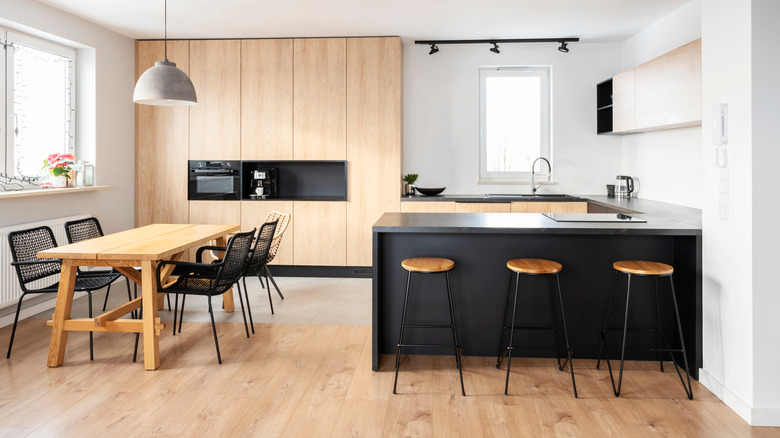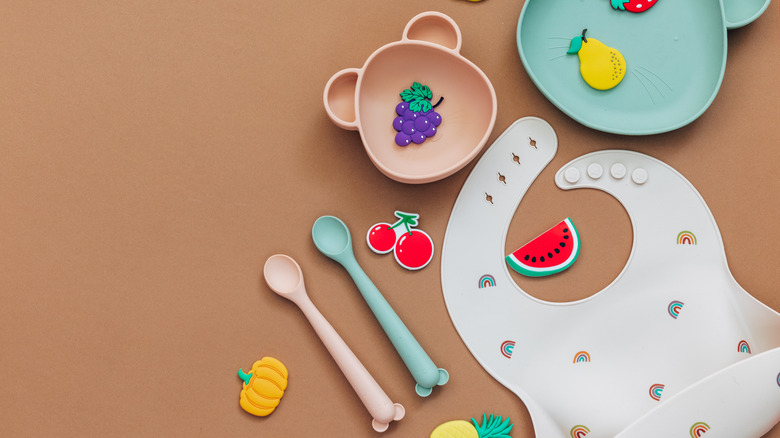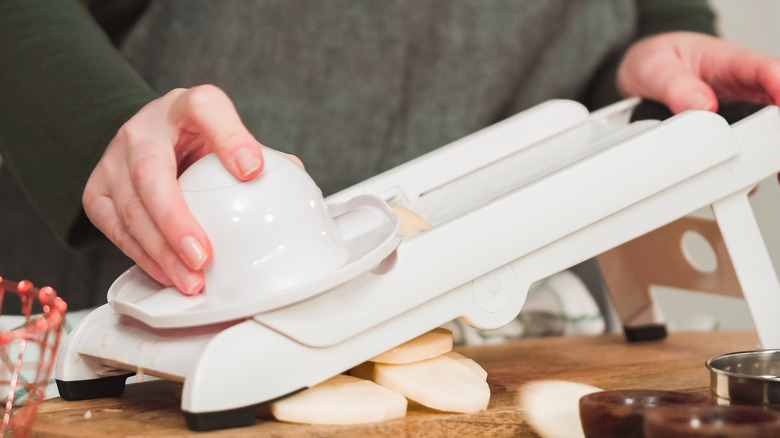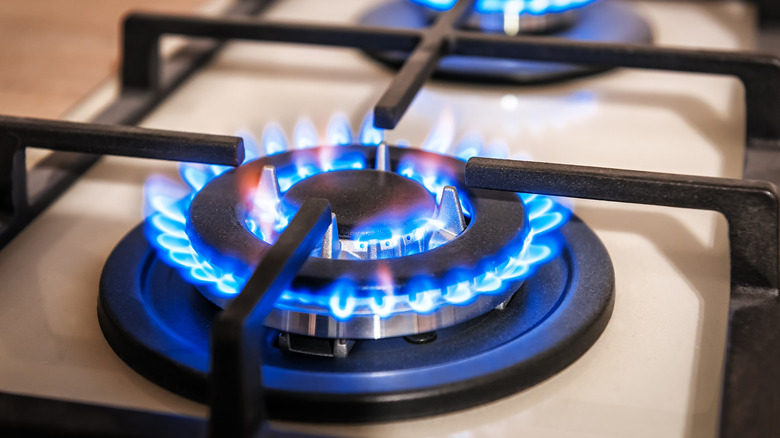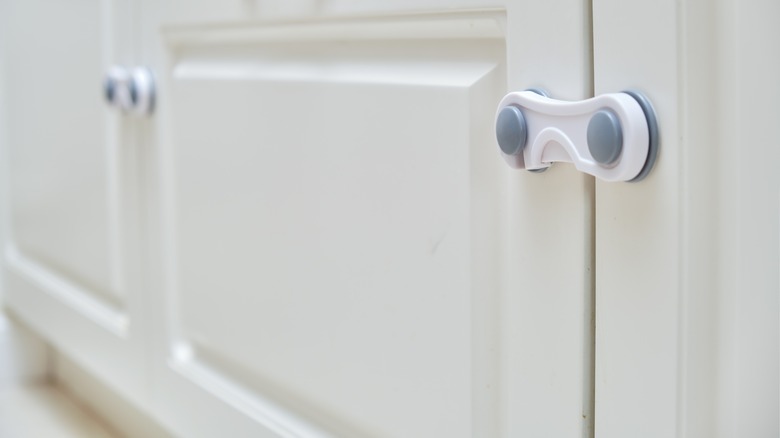4 Tips For Child-Proofing Your Kitchen
Modern kitchens are filled with hazards and potential injuries, especially when children are involved. Beaumont Emergency Hospital reports that two-thirds of all home fires originate in the kitchen, and kitchen knives are responsible for approximately 350,000 injuries annually. Moreover, 7.1% of emergency room patients that are seen due to kitchen mishaps are children aged 5 and younger, per Food Safety Superhero. In view of the potential for burns, cuts, fires, falls, and floods, not to overlook shocks, ingestion of toxic substances, or crushing injuries, child-proofing your kitchen is a must.
Fortunately, there is a full menu of child-proofing ways to keep your kitchen safe and preserve your sanity while you're working at the stove. In fact, HomeLane recommends doing so before making safety improvements in any other room, even the inherently dangerous bathroom. While anticipating problems and safe cooking practices will help gain peace of mind, there are several other things to consider.
Anticipate and eliminate kitchen hazards
Child-proofing a kitchen involves taking precautions as well as instructing and educating a child in safe kitchen practices. Take time to analyze potential problems when planning your child-proofing strategies, and try to anticipate what an active and curious child might do in the kitchen. Romper even mentions getting on your hands and knees to view the kitchen from a toddler's perspective. In addition, BabyCenter suggests designating a cabinet or drawer for the child's use (keeping all others locked), while you do the adult kitchen activities. They can be filled with plastic containers, kids' utensils, or wooden implements. A toddler in the kitchen is safer when strapped in a highchair, while other chairs should have leg locks attached so an active child does not use them as ladders.
Electrical outlets should be equipped with safety plugs. Kitchen tables with sharp edges should have protective corner guards. Kitchen floors need to be safe for children. A young child may pick up food that has been dropped, so flooring that is easy to clean and disinfect is helpful. A safe floor is a skid-proof one. Per Great British Kitchens & Interiors, a composite or polished and sealed stone kitchen countertop is practical from a cleaning and hygienic point of view as well. Have a fire extinguisher nearby, and keep Poison Control's phone number handy. As a last resort, install gates to block all kitchen entrances from encroachment by a toddler during cooking times.
Safe storage of food, supplies, and the garbage bin
Knives, peelers, graters, mandoline slicers, and food processor blades should be treated with respect and secured away from children, per Gadgets For The Kitchen. Plastic bags are a choking hazard and also need to be safely stowed when not in use, and disposed of carefully. Boxes containing aluminum foil, wax paper, or plastic wrap have serrated edges and should be kept out of children's hands. Arrange the kitchen so spices or alcoholic beverages are not accessible to the little ones, and make sure anything small or eye-catching also is not within their reach.
A refrigerator's lower shelves should be reserved for packaged foods only, and open or ready-to-eat foods should be isolated on a higher level, far from a child's hands. Children should not be able to reach garbage bins, which should also be lidded. Kitchen garbage should be emptied each day or when the can is filled. Kids should not be able to reach heavy pots, pans, or dishes on their own.
Needless to say, anything toxic or caustic should be off-limits, therefore, lock detergents away or otherwise keep them out of reach, especially the tempting cleaning pods. Switching to safer, natural products is another child-friendly move. Great Buy Cabinets also suggests turning your kitchen into a toddler-safe no-plant zone.
Follow prudent cooking practices
According to Mom Loves Best, an estimated 300 children are treated daily in ERs for kitchen burns. One way to avoid those incidents is to never leave the kitchen stove unattended while cooking and at no time should you leave a child unsupervised in the kitchen. Besides being a recipe for burns, the Association of Home Appliance Manufacturers attributes taking the eye off the ball as the prime cause of kitchen fires.
Parents offer these additional safe-cooking tips: Cook food on the back burners if possible, with pot and pan handles pointing toward the wall and away from the user. Repair or discard cooking equipment with loose handles, and make sure that flammable objects are not anywhere near the heat. Never hold a child or hot beverage at the same time, and carry hot food slowly and with care. If you are using gas appliances, inspect them regularly to make sure the system, including pilot lights, is working properly. Open hot oven doors cautiously, especially if a child is close by. Teaching your child the ABCs of cooking safety and safe kitchen behavior will go a long way in the future.
Child-proof kitchen appliances
The Consumer Product Safety Commission advises that stoves, cabinets, or refrigerators should be secured by anti-tip brackets, bolts, or cables. Dishwashers also need to be secured. They can be locked, or the control panel covered, and it is recommended not to fill with detergent until using. Consider a kitchen faucet with anti-scalding capability, or lower the temperature of your water heater.
Kitchen Cabinet Kings recommends an induction cooktop, which only heats magnetic pots and pans, and is capable of a quick cool-down. Think of using a stove guard, or removing the control knobs and hiding them from children. A microwave should not rest on the counter. Instead, secure it high above another appliance, and don't let cords dangle from small appliances.
There are various types of devices available, including magnets, straps, pull cords, or velcro, that allow cabinets or drawers to be locked or latched. A cabinet can be outfitted with soft-close hinges so it does not snap shut, or it can have no handles at all. Last but not least, store the cookie jar too far away to reach so junior does not eat 25 chocolate chip cookies at one time.
